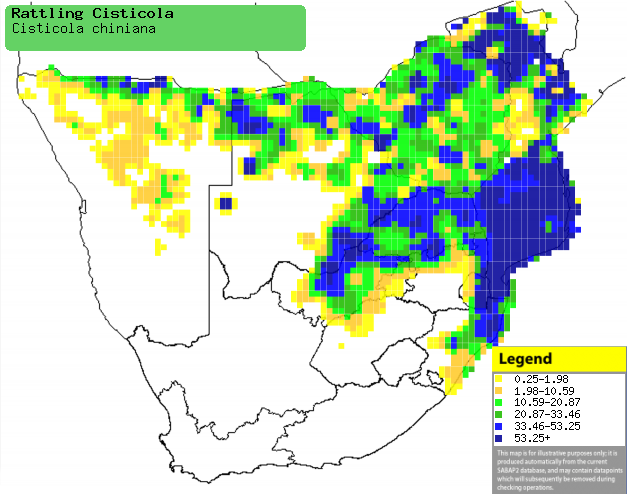|
Cisticola chiniana (Rattling
cisticola)
Bosveldtinktinkie [Afrikaans]; iNqoba [Zulu]; Harudeve
(generic term for cisticola or prinia) [Kwangali]; Timba (generic name for
cisticolas and warblers) [Shona]; Jekwa [Swazi]; Mantsiyana [Tsonga]; LekgÍrÍ
[Tswana]; Ratelgraszanger [Dutch]; Cisticole grinÁante [French];
Rotscheitel-zistensšnger [German]; Fuinha-chocalheira [Portuguese]
Life
> Eukaryotes >
Opisthokonta
> Metazoa (animals) >
Bilateria >
Deuterostomia > Chordata >
Craniata > Vertebrata (vertebrates) > Gnathostomata (jawed
vertebrates) > Teleostomi (teleost fish) > Osteichthyes (bony fish) > Class:
Sarcopterygii (lobe-finned
fish) > Stegocephalia (terrestrial
vertebrates) > Tetrapoda
(four-legged vertebrates) > Reptiliomorpha > Amniota >
Reptilia (reptiles) >
Romeriida > Diapsida > Archosauromorpha > Archosauria >
Dinosauria
(dinosaurs) > Saurischia > Theropoda (bipedal predatory dinosaurs) >
Coelurosauria > Maniraptora > Aves
(birds) >
Order: Passeriformes > Family: Cisticolidae
> Genus: Cisticola
Distribution and habitat
Occurs from Ethiopia south to through the DRC, Tanzania,
Angola and Zambia to southern Africa. Here it is locally common in Acacia
savanna, young woodland on old cultivated land, gardens and patches of bush in
open grassland.
|
 |
|
Distribution of Rattling cisticola in southern
Africa, based on statistical smoothing of the records from first SA Bird
Atlas Project (©
Animal Demography unit, University of
Cape Town; smoothing by Birgit Erni and Francesca Little). Colours range
from dark blue (most common) through to yellow (least common).
See here for the latest distribution
from the SABAP2. |
Predators and parasites
It has been recorded as prey of the following animals:
One bird was found with fowl-pox and with ticks (Hyalomma
rufipes) blocking its ears.
Brood parasites
It has been recorded as host of the
Diderick
cuckoo and
Brown-backed honeyguide.
Food
It mainly eats invertebrates, often foraging in the
undergrowth and on the ground, occasionally plucking termite alates from the air. The following food items have been recorded
in its diet:
- Insects
- Snails
- Nectar
- Aloe marlothii (Mountain aloe)
- Aloe greatheadii (Spotted aloe)
Breeding
- The nest is an oval or ball shape with a side entrance, built of dry grass
secured with spider web. It is typically attached with spider web to a grass
tuft, shrub, Acacia sapling or a fallen branch's foliage, usually up
to 1.2 metres high.
- Egg-laying season is from October-April, peaking from about
November-January.
- It lays 2-5 eggs, which are incubated solely by the female for roughly
13-14 days.
- The chicks stay in the nest for about 13-15 days.
Threats
Not threatened.
References
-
Hockey PAR, Dean WRJ and Ryan PG 2005. Roberts
- Birds of southern Africa, VIIth ed. The Trustees of the John Voelcker
Bird Book Fund, Cape Town.
-
|
